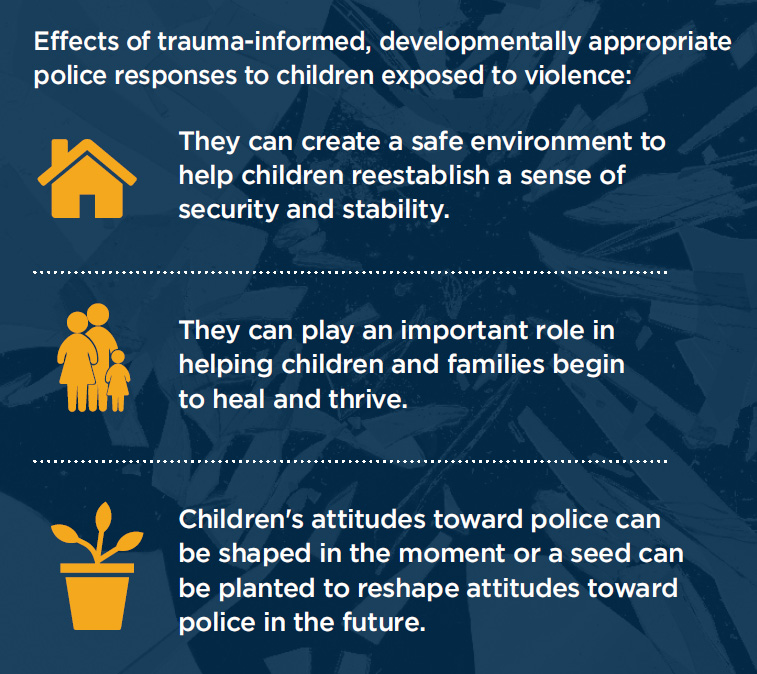The high number of children exposed to violence in their homes, schools, and communities and the following traumatic disruption to their development constitute a public health crisis.
The third National Survey of Children’s Exposure to Violence found that one in three children reported having been physically assaulted; almost one in four children reported witnessing violence in their homes, schools, and communities; and almost one in ten children reported seeing a family member assault another in the past year.
When children and adolescents experience a traumatic stress reaction following a violent event and are not supported in recovering, they are at a higher risk for further victimization and violence, mental health disorders, substance abuse disorders, involvement with the criminal justice system, poor school performance, physical health problems, and even early death. These effects can result from both direct and indirect exposure to violence, encompassing seeing violence, hearing it, hearing about it, or seeing the aftermath.
 Situations that lead to children’s exposure to violence are often the same ones to which frontline officers respond. This means officers are well-positioned to help initiate a child’s recovery. Police officers are a key protective factor and play a major role in the lives of vulnerable children; thus, responding effectively to children at the scenes of potentially traumatic events by using developmentally appropriate, trauma-informed approaches is vital. Law enforcement can be a powerful partner in restoring a sense of order and beginning the healing process for children.
Situations that lead to children’s exposure to violence are often the same ones to which frontline officers respond. This means officers are well-positioned to help initiate a child’s recovery. Police officers are a key protective factor and play a major role in the lives of vulnerable children; thus, responding effectively to children at the scenes of potentially traumatic events by using developmentally appropriate, trauma-informed approaches is vital. Law enforcement can be a powerful partner in restoring a sense of order and beginning the healing process for children.
Online Training Series
The International Association of Chiefs of Police (IACP) and the Childhood Violent Trauma Center at the Yale Child Study Center (Yale), in partnership with the Office of Juvenile Justice and Delinquency Prevention (OJJDP), Office of Justice Programs, U.S. Department of Justice, developed an online training series for law enforcement to help address this crucial area. Protecting and Serving: Enhancing Law Enforcement Response to Children Exposed to Violence has been certified through the IADLEST National Certification Program as law enforcement in-service and continuing education training.
The training series consists of five modules:
- Module 1 – Introduction to Children Exposed to Violence
- Module 2 – Understanding the Impact of Violence and Trauma
- Module 3 – Trauma and Recovery
- Module 4 – Effective Police Responses to Traumatic Stress in Children at Different Ages
- Module 5 – The Role of the Police Officer in the Lives of Children Exposed to Violence
This training series helps officers understand the typical development of children at different ages, what traumatic reactions in children look like, and practical actions that officers can take when responding to children in a state of distress. It enables officers to identify children exposed to violence they encounter while on the job, interact effectively with children of all ages who have been exposed to violence, and employ developmentally appropriate and trauma-informed approaches. This, in turn, can increase professional effectiveness and satisfaction, as well as help children and families start on the path to recovery. Police officers do not need to be experts on child development to use their skills of observation and problem-solving to help children who have been exposed to violence.
Law Enforcement Toolkit
In addition to the online training, the IACP and Yale, with support from OJJDP, launched multiple tools and resources in the Enhancing Police Responses to Children Exposed to Violence: A Toolkit for Law Enforcement. This publication provides practical tools and resources to assist law enforcement agencies in building or enhancing effective operational responses to children exposed to violence (with or without a mental health partner). This resource contains tools organized in four types: informational, operational protocols, assessment, and operational tools.
Informational
- A Law Enforcement Executive’s Brief on Children Exposed to Violence
- The Officer’s Role in Responding to Traumatized Children
Operational Protocols
- On-Scene Acute Protocol for Children Exposed to Violence
- Protocol for Responding to the Needs of Children at Scenes of Domestic Violence
- Principles and Practices of Death Notification to Children
Assessment
- Organizational Self-Assessment Tool
- Action Planning Tool
Operational Tools
- Reactions That Police May Observe from Children and Youth
- What Traumatic Stress Reactions May Look Like On-Scene
- Effective Police Responses to Traumatic Stress in Children of Different Ages
- Commonly Asked Questions from Children and Example Police Responses
- Common Issues with Caregivers and Police Responses
- What to Do When Your Child Is Exposed to Violence – Brochure
- Teaching the Tactical Breathing Technique to Children and Parents


